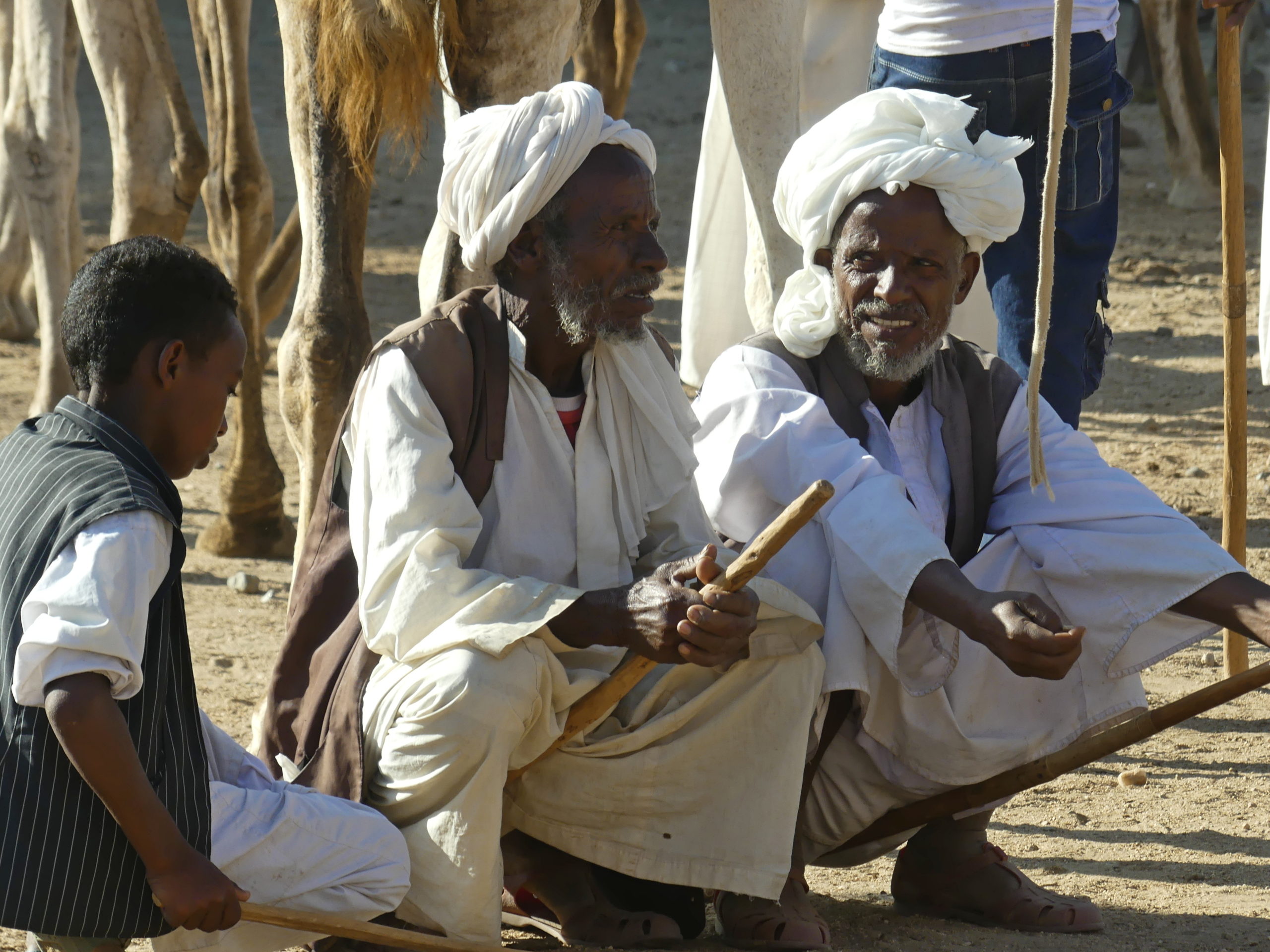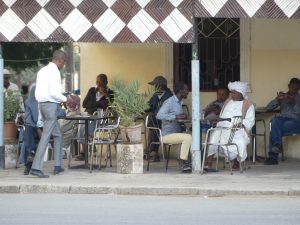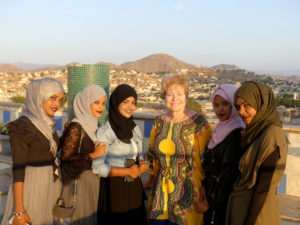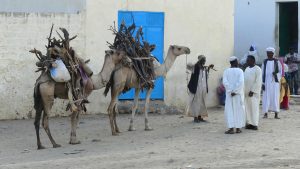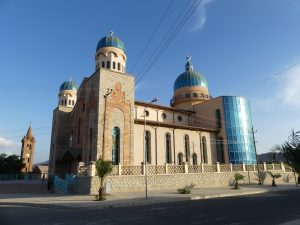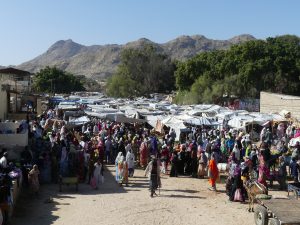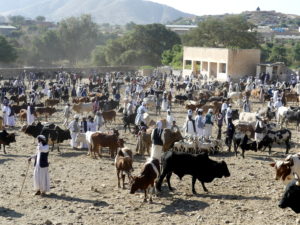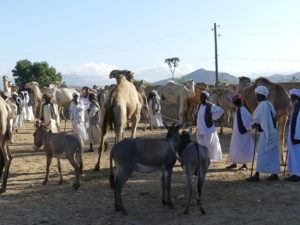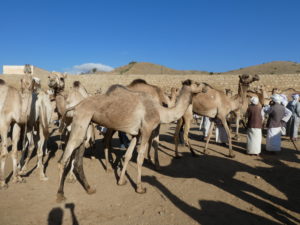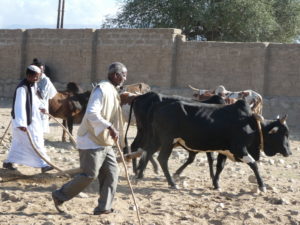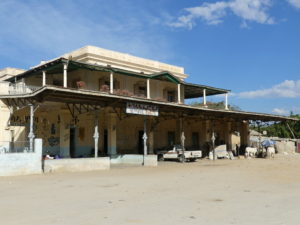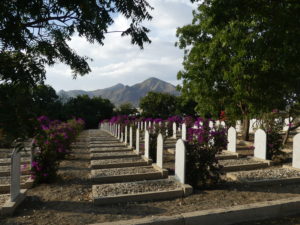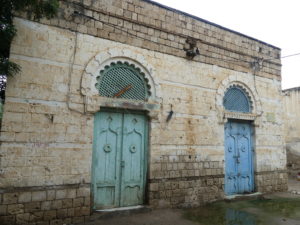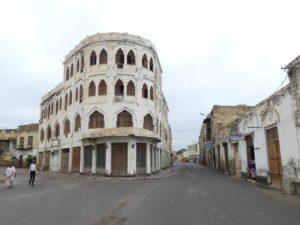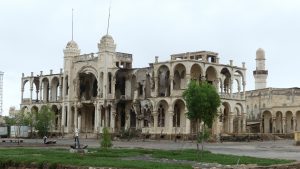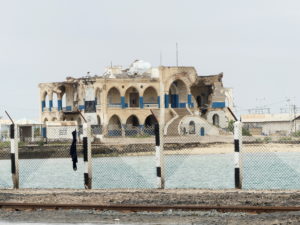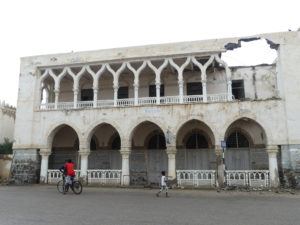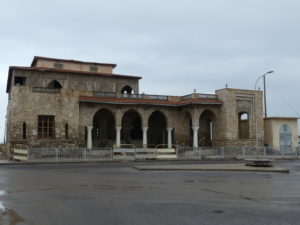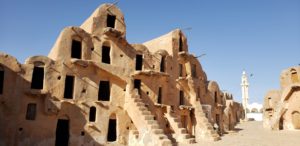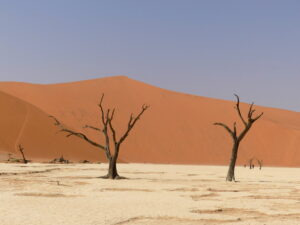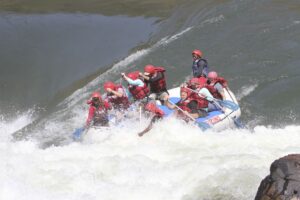The regional market town of Keren
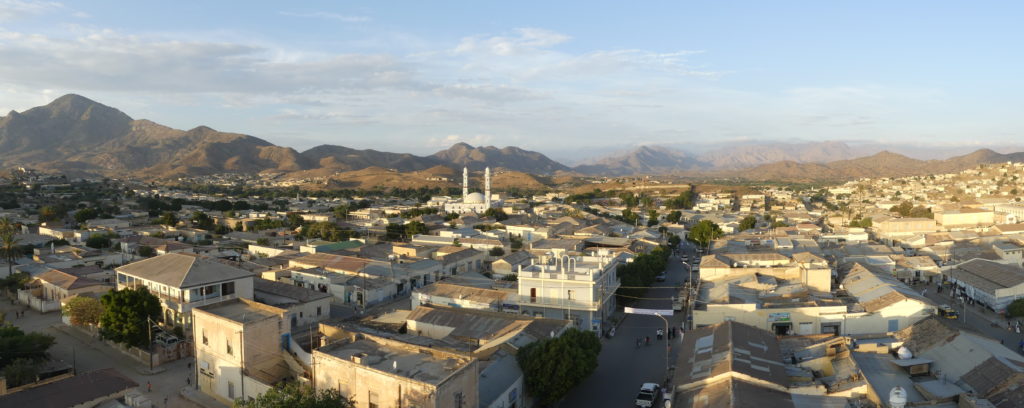
Evening settled into Keren, the principal city of central Eritrea, after the golden sunset flared behind its encircling mountains. Our viewpoint, from atop a swaying metal staircase on the highest building in town, showed a pleasing creamy patina to the entire city.
It seemed that the whole populace of 80,000 appeared – thronging the coffee shops and the daily food market, or ambling – on the streets. This is clearly the time to put aside work in order to shop and socialize with friends or family.
After enjoying the evening view, we dawdled at the rooftop bar/café, then traded photos with some local young women who had climbed there also for their social gathering. Though their heads were scarved and they wore a veil-like outer layer, each had heavily applied make up to her face and had squeezed into form-fitting pants for the get-together.
Nearby, other social gatherings enlivened the streets of Keren like this herders’ group at the edge of an arcaded market street, which is busy throughout the day with merchants and shoppers.
Just a few blocks away from the social center, we had been reminded about the diversity of this city’s community. A recently completed Catholic church in a very eclectic style loomed over the tower of the old Italianate one in central Keren, while close by too stood mosques and Coptic churches to serve the other major religions here.
During the day, Keren is the epicenter of the region for markets, especially on Mondays. Then a sprawling goods/foods market fills a seasonally dry river bed in the center of town. We even considered buying some of the handicrafts that colorfully swathed women were weaving or beading in a narrow lane of the river market.
At a hillside area above a dry riverbed in the town’s outskirts, by contrast, there’s a very different and animated livestock market (known far and wide for its trade in camels, but even busier in cattle, sheep and goats).
Buyers wander about assessing the camels throughout the day. We regretted that we could not figure out how to carry away any of the young ones on sale.
The camels traded here are used for various forms of work, from plowing to carrying loads of wood to smuggling goods across the border – but are never eaten for food. A worthy camel can cost up to $1500 USD at this market. After your sharply negotiated purchase, the tax agent at the exit gate collects the government’s $100 USD fee.
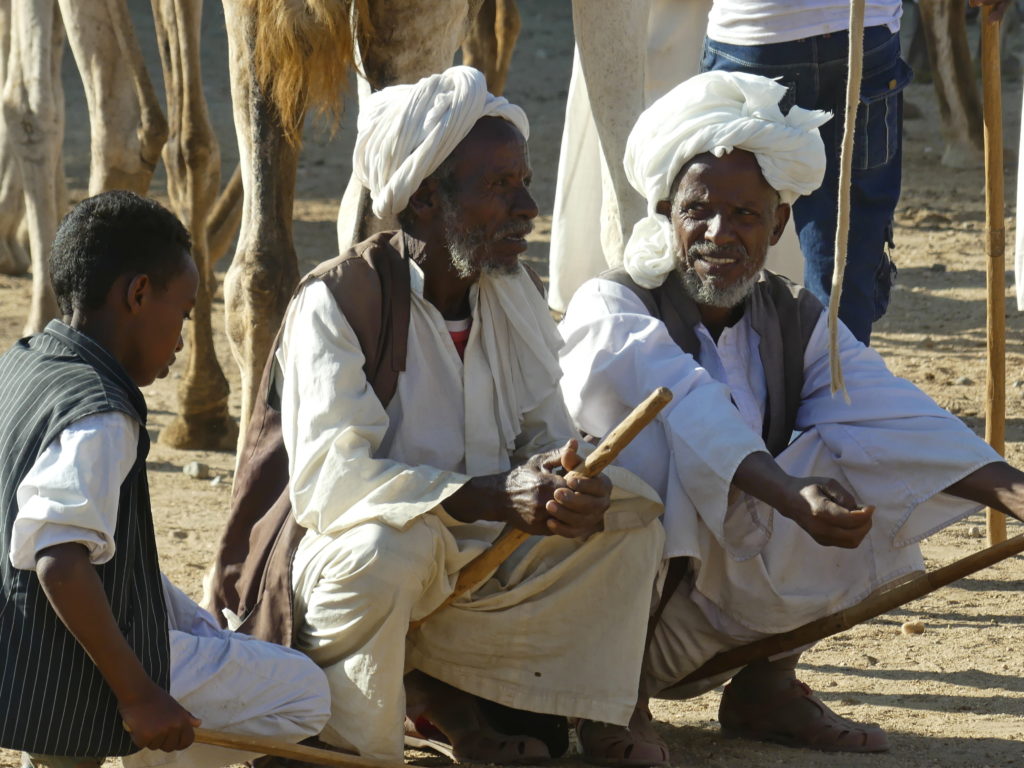
Keren’s livestock market was more hectic, for sure, than the relatively sedate camel market, perhaps because the plentiful sheep and goats tended to be a lot more obstreperous than camels.
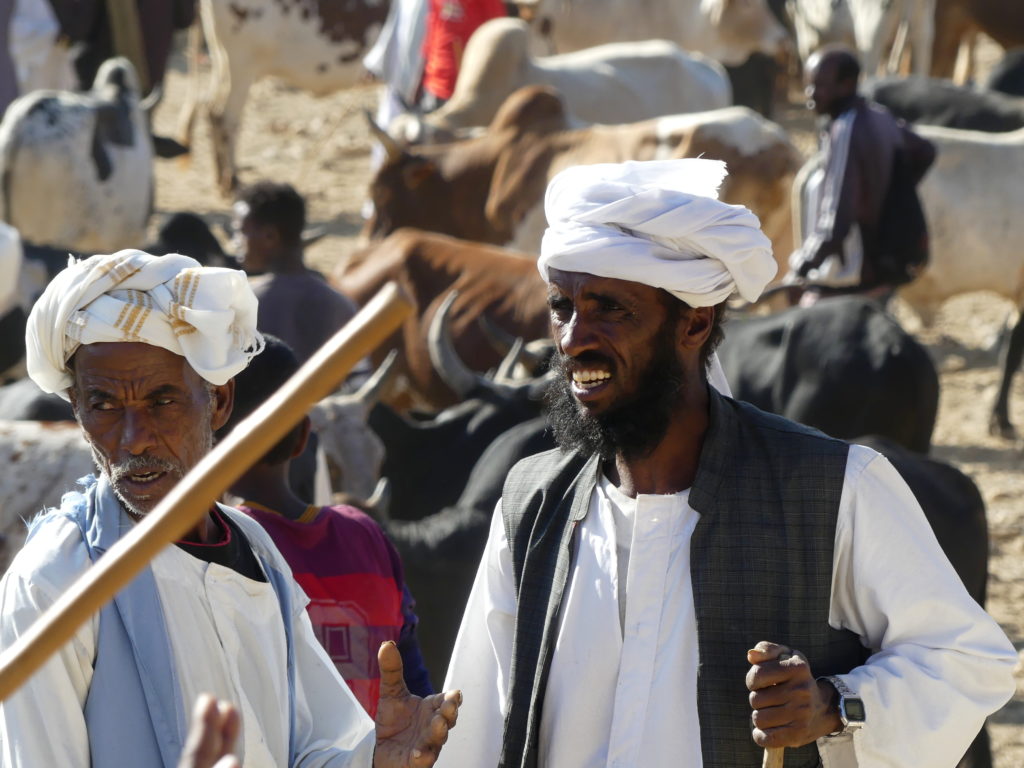
And then over to one side of the livestock market, several men were test-driving pairs of plow bulls. They want to make sure the two work well together and do the job for which they are paying.
Keren was a hub of trade in the past as well. The old rail station of Keren, built by the Italian colonizers, was once connected by rail through the capital of Asmara to the coastal port of Massawa. It’s now the site where the various ramshackle minivan busses gather to transport locals around the region and town.
Though Italy formally ceded its occupation of the country to the British, subsequent generations still wished to honor their dead in the land they wanted to defend. So, backed by Keren’s encircling hills, there is a lovingly landscaped Italian cemetery in which are buried many of the soldiers who fought and died around Keren during Mussolini’s defense of the area during World War 2. A lonely caretaker keeps the place in fine shape. The continuation of the cemetery is an honor to Eritreans who respect it despite the harsh Italian rule of the past. None of the Eritreans who died for the Italian side are recalled in the cemetery except as Unknown Native (Ascaro ignoto).
The rail line was torn up and, along with the train system equipment, sold off by the British after World War 2. Italian manufacturing plants at Dekemkhari were gutted and the equipment also sold. Why? Partly for the money, and partly so they could represent Eritrea as economically unfit to stand on its own, and needing to be federated with Ethiopia.
Sea trade at old Massawa; decay at the new
In the first millennium AD, Eritrea’s ancient port city of Adulis was a center for trade on the Red Sea until its importance declined. The name Eritrea itself derives from the local words for Red Sea.
That site is difficult to reach, but we did visit the “new” port city of Massawa to the south.
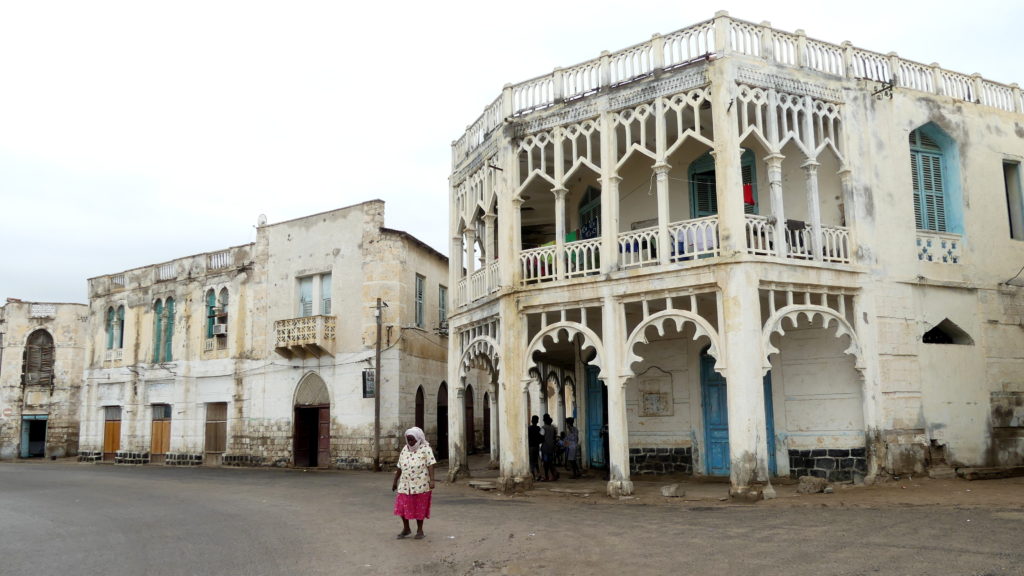
By the late 19th century, first Egypt and then the Ottomans built a new thriving port at Massawa, a sizable island just several hundred meters off the Eritrean mainland. It was, in effect, the capital of the country for them.
These layers of occupation history became more obvious after our eyes were tutored by our guide. The bricks of these merchant buildings, for example, were made of a hardy coral plentiful in the Red Sea. The Egyptians smoothed the coral before using it in buildings; the Ottomans used rough, pockmarked coral in theirs.
When the Italians moved into the country, despite shifting their capital to the healthier, cooler highland city of Asmara, they continued to benefit from the port until they lost their colony in WW2. From that time, one of the few original Italian-built structures, Il Torino stands proudly on a city intersection. It imitated Islamic styles, but added the art deco touch of a curved prow.
The Italians even rebuilt extensively after a 1921 earthquake destroyed much of the merchant and shipping buildings.
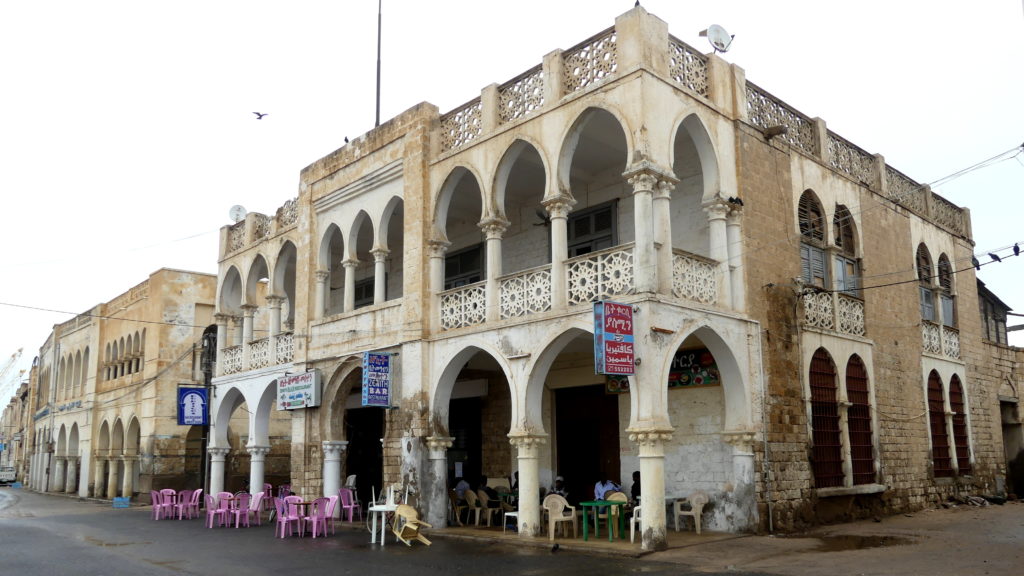
The Egyptian-era building above was restored after the earthquake by Italian architects, and is still being used as a bar/café.
Neglect and then the battles of the War for Independence left hulking structures and vacant buildings. Most notable among these is this one, the grandest of the pre-Italian era buildings, which still shows all the effects of earthquake and war including shrapnel gouges.
Across a channel you can also peer at what’s left of the Egyptian Governor’s Mansion, one that was turned into a summer palace for the Ethiopian emperor Haile Selassie during his troubling reign. At the local museum, we saw some of the elaborately carved furniture he used, removed from the mansion before the building was bombed in the Independence War.
But many other restorations, however dingy they may seem now, fill the town, like this one at another city intersection in a very eclectic style.
There have been various efforts to revive the port and the city, such as development of extensive residential buildings and hotels on the adjacent peninsula for tourism. But these too are decaying in the humid air of the coast and haphazardly used still.
Attempts to revive the old post office building on Massawa Island, the first such effort here in years, became controversial due to stylistic and monetary issues. Awaiting some final approvals, it remains closed off to business.
But most of this has stalled while a viable border with Ethiopia and economic collaboration remains uncertain. We stayed at a sprawling grand hotel built with optimism on the peninsula, but now failing due to lack of maintenance and investment.
Meanwhile, the impressive hulks of the old island, occupied solely by some hearty or perhaps fool-hardy residents, await a better future.
(To enlarge any picture above, click on it. Also, for more pictures from Eritrea, CLICK HERE to view the slideshow at the end of the itinerary page.)


